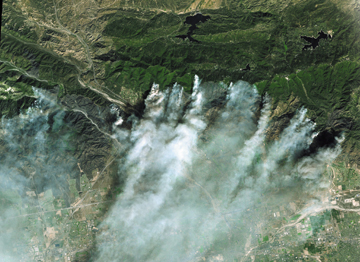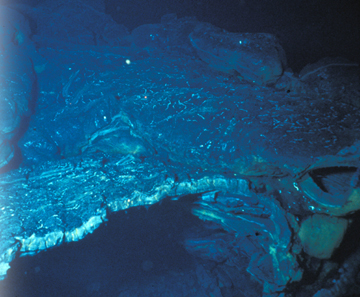
 The devastating
fires that ravaged Southern California this fall burned more than 1,100 square
miles of land, leaving a stark landscape in their wake. The fires killed 20
people and destroyed thousands of homes and hundreds of thousands of trees.
Fire also interrupted data flowing from seismic and GPS networks operated by
the U.S. Geological Survey (USGS) and partner organizations, temporarily halting
part of the region’s earthquake monitoring system. In the months following
the fires, people are beginning to rebuild, but the hillsides remain largely
bare.
The devastating
fires that ravaged Southern California this fall burned more than 1,100 square
miles of land, leaving a stark landscape in their wake. The fires killed 20
people and destroyed thousands of homes and hundreds of thousands of trees.
Fire also interrupted data flowing from seismic and GPS networks operated by
the U.S. Geological Survey (USGS) and partner organizations, temporarily halting
part of the region’s earthquake monitoring system. In the months following
the fires, people are beginning to rebuild, but the hillsides remain largely
bare.
On Oct. 26, the Advanced Spaceborne Thermal Emission and Reflection Radiometer
(ASTER) onboard the Terra satellite captured this image of the Old Fire/Grand
Prix fire burning on either side of Interstate 15 near the Cajon Pass in the
San Bernardino Mountains, roughly 80 kilometers east of Los Angeles, Calif.
The image is simulated natural color, showing how the scene would look from
above to a human eye. Image courtesy NASA/GSFC/METI/ERSDAC/JAROS, and U.S./Japan
ASTER Science Team.
The charred landscape is presenting an unprecedented research opportunity, however,
for geoscientists studying fault zones, debris flows and flooding, and ecosystems
in the region. USGS researchers are at the forefront, hoping to use this opportunity
to plan for and mitigate hazards in the future, says Susan Cannon, a geologist
with USGS in Denver.
The fires burned off all the vegetation covering miles of fault-ridden hillsides,
including hazardous sections of the San Andreas, Sierra Madre and Cucamonga
faults. Researchers can now observe the faults and past earthquake deformation
scars and obtain “bare earth” images like never before, says Ken Hudnut,
a USGS geophysicist in Pasadena, Calif.
Light detection and ranging aerial mapping (LIDAR) can provide digital, high-resolution
topographic data through dense groundcover and foliage. “However, LIDAR
works even better without any obscuring vegetation,” Hudnut says. If geologists
could take aerial photographs and LIDAR images of the faults before vegetation
regrows, then they could better map subtle geomorphic features along the faults.
These features would provide timing constraints, slip histories and rupture
lengths of past fault ruptures, all needed to produce seismic hazard assessments
along the heavily populated sections of these faults.
The denuded hillsides are also presenting research opportunities related to
flood and debris-flow risks, Cannon says. Vegetation ordinarily holds soils
in place, so once winter rains set in, the slopes are at high risk for flash
flooding and debris flows. And with a small El Niño predicted this year
by the National Oceanic and Atmospheric Administration, mountainous Southern
California can expect heavier than usual rains. The counties already have rain-gauge
networks in place, and USGS has stream gauges in many of the hazardous channels.
Researchers can plug real-time rain- and stream-gauge information into a rainfall
intensity/duration threshold computer model to help forecast flood and debris-flow
events, Cannon says. They can then implement a real-time flood and debris-flow
warning system.
Using data from throughout the West, Cannon and colleagues have also developed
models for assessing the probability of debris flow from individual basins and
the magnitude of the response. Adding data from the recently stripped hillsides
to these models, Cannon wants to refine the models to make them specific to
Southern California. Doing so will help predict which basins are most susceptible
to debris-flow activity and which communities have the greatest risk for debris
flows and flooding the next time fire strikes.
The scope and magnitude of the fires have also created a unique opportunity
to study the effects of fire on the natural environment. One such study involves
looking at the effect of fire suppression policies on the forests. The fires
burned right through major stretches of landscape that were only a few years
old just as readily as they burned through the older shrublands with high fuel
loads, says Jon Keeley of USGS in Three Rivers, Calif. The Cedar Fire in San
Diego tore through several prescription burns of a thousand acres or more each.
“And over 40 percent of the 60,000 acre Otay Fire burned through a landscape
that had burned completely in 1996,” Keeley says.
The Healthy Forests Restoration Act, passed into law on Dec. 3, aims to protect
old-growth forests and communities from catastrophic wildfires by reducing the
fires’ natural fuel. The legislation dictates that at least half of the
funding for fuel reduction projects must be used in wildland-urban border areas,
such as the San Bernardino Mountains. But the majority of acreage burned in
the fires this fall was in shrublands.
Research has clearly demonstrated that landscape-level fuel treatments have
no ability to stop these catastrophic events, Keeley says. More research is
needed to figure out how to best protect people and property in the region.
Meanwhile, nature plugs on: Winter rains come, hillsides try to maintain their
ground, and vegetation begins to sprout over the faults.
Megan Sever
Back to Top
Right now, thousands of meters beneath the ocean surface, at near-freezing
temperatures and extremely high pressures, lava is erupting somewhere along
the mid-ocean ridge system, the 56,000-kilometer-long volcanic mountain chain
that encircles the globe.
 Geologists studying the seafloor near
mid-ocean ridge volcanoes have found strange features, presumed to have formed
from molten lava, as much as a few kilometers away from the eruption sites.
These features include jagged-edged holes, collapsed pits and open cavities.
Some pits contain lava pillars — short hollow tubes rising through the
cavity from a floor scattered with pieces of fractured basalt.
Geologists studying the seafloor near
mid-ocean ridge volcanoes have found strange features, presumed to have formed
from molten lava, as much as a few kilometers away from the eruption sites.
These features include jagged-edged holes, collapsed pits and open cavities.
Some pits contain lava pillars — short hollow tubes rising through the
cavity from a floor scattered with pieces of fractured basalt.
Scientists study rocks from the mid-ocean ridge, hoping to better understand
how steam helps to create lava-related features, such as this collapsed pit,
many kilometers away from eruption sites. Image courtesy of Mike Perfit.
Now, scientists have discovered curvy, or cuspate, drip-like features on the
undersides of pieces of lava from the roofs of cavities on the East Pacific
Rise, a ridge 700 kilometers southwest of Acapulco, Mexico. The discovery has
led scientists to identify a mechanism that not only explains the seafloor features,
but also how still-molten lava could form these features so far from the vent.
That mechanism is steam.
The cuspate drip features on the samples, taken from depths of about 2,500 meters,
exhibit the work of “bubbles and cavities of briny vapor at magmatic temperature
that existed during formation of the drip,” says Mike Perfit, a marine
geologist at the University of Florida, who published these findings with colleagues
in the Nov. 6 Nature.
Previously, researchers did not think that seawater could boil at the high pressures
found on the mid-ocean ridge. Thus, the new finding is very interesting, says
Bill Chadwick, a marine geologist with Oregon State University, “and they
document it very well.”
Steam also helps the lava travel many kilometers from the vent without being
quenched by ice-cold seawater, Perfit says. As the molten lava rolls over the
seafloor, water trapped in fractures below is able to boil, making a carpet
of steam on which the lava can more easily flow. The cavities insulate the lava,
allowing it to flow farther. The rolling process may also explain the extreme
smoothness of some lava-flow surfaces, despite flowing over uneven ground.
“These lavas come out and skate around on top of this very expanded vapor
phase,” Perfit says. “This may be a really significant volcanological
aspect of how you create the upper part of the seafloor.”
Steam bubbling up through the lava creates the hollow pillars and pockets under
the lava shell, allowing lava to form the drips and cuspate features found on
the East Pacific Rise samples, Perfit says.
Historically, most geologists have agreed that the features were due to molten
lava flowing beneath a hardened glassy shell of lava. But they attributed the
features to “lava drain-away,” in which lava flows down a hill, draining
the area it just traveled through and causing the glassy shell to collapse.
“The problem with that was, we didn’t ever see that much drained-away
lava,” Perfit says. “If you have a large volume of it that just erupted,
and it drains away, you need to be able to find all that material.” Another
problem is that drain-away would cause a vacuum beneath the hardened shell,
which would then cause the entire sheet to collapse instantaneously, he says.
Some researchers have suggested that magmatic gases bubbling out of the lava
would cause the vapor pockets. However, Perfit says, magmatic gases couldn’t
account for the size of the cavities produced or their distances from the vent.
Also, scanning electron microscope investigations of the samples have shown
a variety of unusual minerals and the presence of once-molten salt fused to
the drip features, Perfit says. Salt would come from seawater and not magmatic
gases. If the salt had precipitated out of seawater long after the drip features
formed, it would be present as salt crystals. The lack of crystals means the
seawater reached temperatures high enough to melt salt (around 800 degrees Celsius),
which, in turn, means it went through a vapor phase, he says.
However, many questions remain to be answered, including why the molten salt
has not dissolved despite exposure in undersaturated seawater. Perfit and colleagues
also hope to further understand the influence of steam on lava chemistry and
its role in the formation of new seafloor.
“I agree with the evidence they cite that says this actually happens,”
Chadwick says. “But where there’s room for different interpretations
is exactly how it happens, under what circumstances and to what extent.”
Sara Pratt
Geotimes contributing writer
Back to top
 |
Geotimes Home | AGI Home | Information Services | Geoscience Education | Public Policy | Programs | Publications | Careers |